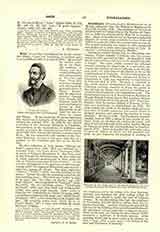

Grün, ANASTASIUS, pseudonym for Anton Alexander (Maria), Count von Auersperg, an Austrian poet; b. at Laibach in 1806; d. at Graz in 1876. He received his earliest training at the Theresian academy at Vienna, and later studied philosophy and jurisprudence at Vienna and Graz. From 1831 on he was occupied with the care of his paternal estates at Thurn. Repeatedly he undertook journeys through Italy, France, and England, until he married a Countess Attems in 1839. Henceforth he divided his time between his estates and Vienna. In the meantime his poems had made him famous as a champion of liberalism, and he had entered the political field. In 1848 he was elected a member of the National Assembly at Frankfort. Disappointed in his expectations, he withdrew and retired to private life, from whence he did not emerge until 1860, when Austria had become a constitutional State. He was appointed a life member of the Austrian Reichsrat, serving at the same time first as a member of the Carniolan and then of the Styrian diet.
His first collection of lyric poems, “Blatter der Liebe”, appeared in 1830. This was followed by a romantic cycle, “Der letzte Ritter” (Stuttgart, 1830), in praise of Emperor Maximilian I. But fame came to him through his political poems, the first collection of which appeared anonymously in 1831 under the title of “Spaziergange eines Wiener Poeten”. It was a severe arraignment of the oppressive conditions prevailing under the regime of Metternich, and created a sensation among all classes. The next collection, “Schutt” (“Ruins”-1835), was also political in tendency. Neither this nor the preceding collection has won enduring fame. This Grun owes rather to some of his lyrics, like “Das Blatt im Buche” and “Der letzte Dichter”, which appeared in “Gedichte” (Leipzig, 1837). His two humorous poems, “Nibelungen im Frack” (1843) and “Der Pfaff vom Kahlenberg” (1850), were never really popular. Other works of Grun are the “Volkslieder aus Krain” (Leipzig, 1850), a collection of Slovenic folksongs, and “Robin Hood” (Stuttgart, 1864), a free rendering of old English ballads. His complete works were edited by L. A. Frankl (Berlin, 1877, 5 vols.), new edition by Anton Schlossar (Leipzig).
ARTHUR F. J. REMY

